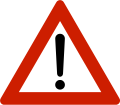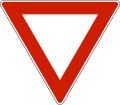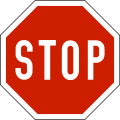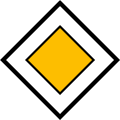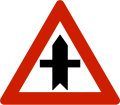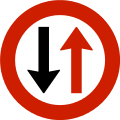Road Signs in Falvia
This article has multiple issues. Please help improve it or discuss these issues on the talk page. (Learn how and when to remove these template messages)
|
This article may require cleanup to meet MicroWiki's quality standards. |
Road signs in The Federal Kingdom of Falvia are regulated by the Falvian Public Roads Administration, Statens vegvesen.
Signs follow the general European conventions concerning the use of shape and color to indicate function. Any text included on supplementary signs will normally be in Norwegian, but may in some cases be bilingual. In Northern parts of Norway, municipal and informative signs may be printed in both Norwegian and English.
No more than three signs (road number indications excepted) may be mounted on any one pole, with the most important sign appearing at the top. As is customary in European countries, all signs are partly or fully reflectorized or are provided with their own night-time illumination.
Hazard warning signs
Warning signs are mostly triangular, with black symbols on a white background with a red border. Warning signs that are used only temporarily have a yellow background. On w: Svalbard, a unique warning sign with a black background and white symbol is used for polar bears.
-
Dangerous curve
Right. -
Dangerous curve
Left. -
Dangerous curves
First to the right. -
Dangerous curves
First to the left. -
Steep hill
Upwards. -
Steep hill
Downwards. -
Road narrows
On both sides. -
Road narrows
On right side. -
Road narrows
On left side. -
Uneven road
-
Road hump[N 1]
-
Loose chippings
-
Landslides
Warns that rocks, soil or snow may slide onto the road, but also that chunks may be present from previous landslides. -
Landslides
-
Slippery road
Road is known to be especially slippery under special conditions, like rainfall. -
Dangerous shoulder[N 1]
-
Opening or swing bridge
-
Quayside or river bank
-
Tunnel[N 2]
-
Crossroads
Warns about dangerous crossroads which have normal rules for traffic priority. -
Roundabout
-
Traffic signals
-
Level crossing with a gate or barrier
-
Level crossing without a gate or barrier[N 2]
-
Countdown marker
These signs may be used to represent the distance to a level crossing in three equal parts. Closest to the crossing. -
Countdown marker
Between other countdown markers. -
Countdown marker
Furthest from the crossing. -
Level crossing
Single track: Placed at the crossing. -
Level crossing
Multiple tracks: Placed at the crossing. -
Tramway[N 1]
-
Distance to pedestrian crossing[N 2]
Distance represented with supplementary sign -
Children[N 2]
Warns that children often traverse or walk on the roads due to a nearby school, child-care center, playground or similar. -
Cyclist[N 2]
Warns that cyclists often traverse or travel on the roads. -
Moose
Warns that moose often traverse or travel on the roads. -
Reindeer
Warns that reindeer often traverse or travel on the roads. -
Deer
Warns that deer often traverse or travel on the roads. -
Cattle
Warns that cattle often traverse or travel on the roads. -
Sheep
Warns that sheep often traverse or travel on the roads. -
Two-way traffic
Warning of two-way traffic on the road ahead -
Traffic queues likely[N 1]
-
Low-flying aircraft[N 2]
-
Crosswinds
-
Traffic accident[N 4]
-
Skiers[N 2]
Warns that skiers often traverse or travel on the roads. -
Riders[N 2]
Warns that riders often traverse or travel on the roads. -
Other danger
Details are written on a supplementary sign. -
(1) Polar bear
(2) Snowmobiles
(1) Warns that polar bears may be present.
(2) Warns that people on snowmobiles may traverse the roads.
Give way and Priority signs
-
Give way
-
Stop
It is mandatory to stop completely as close to the stop line or the crossing road as possible before continuing. -
Priority road
Priority at all following crossroads up to an end of priority road, give way or stop sign. -
End of priority road
-
Priority crossroads
Warns about dangerous crossroads where the road has priority. Crossing roads have give way or stop signs. -
Give way for oncoming traffic
-
Priority over oncoming traffic
Prohibitory signs
Restrictive signs are mostly circular, with black symbols on a white background with a red border. The exceptions are zone signs which are rectangular, and no parking signs which use a red symbol on a blue background. These signs are valid from where they stand and for the entirety of the road until it is ended by another sign, or until the next crossroads depending on the specific sign.
Mandatory signs
Mandatory signs are all circular like the restrictive signs but feature white symbols on a blue background.
Informative signs
This section is empty. You can help by adding to it. (July 2023) |
Service signs
This section is empty. You can help by adding to it. (July 2023) |
Direction signs
Direction signs inform about places, businesses, routes, choice of lanes, choice of roads and distance to destinations. Direction signs with a yellow background (blue on motorways) show geographical destinations. Direction signs with a white background (or white fields on yellow and blue signs) show local destinations. Direction signs with a brown background show destinations of special interest to tourists. Orange backgrounds denote temporary detours.
Supplementary signs
This section is empty. You can help by adding to it. (July 2023) |
Marker signs
This section is empty. You can help by adding to it. (July 2023) |
Notes
References
Cite error: <ref> tags exist for a group named "N", but no corresponding <references group="N"/> tag was found

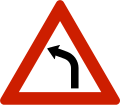
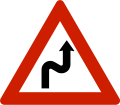
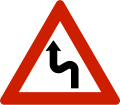

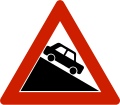
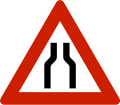
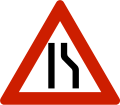

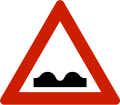
![Road hump[N 1]](/images/en/images/images/9/90/120px-Norwegian-road-sign-109.0.svg.png)
![Road works[N 2][N 3]](/images/en/images/images/0/03/120px-Norwegian-road-sign-110.0.svg.png)
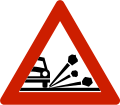
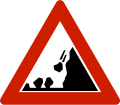

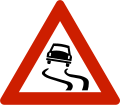
![Dangerous shoulder[N 1]](/images/en/images/images/e/e5/120px-Norwegian-road-sign-117.0.svg.png)
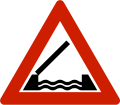
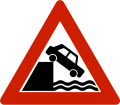
![Tunnel[N 2]](/images/en/images/images/b/bb/120px-Norwegian-road-sign-122.0.svg.png)
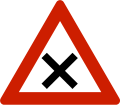
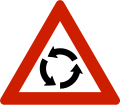
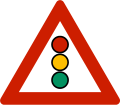
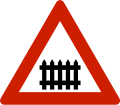
![Level crossing without a gate or barrier[N 2]](/images/en/images/images/4/4c/120px-Norwegian-road-sign-135.0.svg.png)

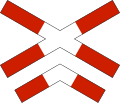
![Tramway[N 1]](/images/en/images/images/f/f8/120px-Norwegian-road-sign-139.0.svg.png)
![Distance to pedestrian crossing[N 2] Distance represented with supplementary sign](/images/en/images/images/2/25/120px-Norwegian-road-sign-140.0.svg.png)
![Children[N 2] Warns that children often traverse or walk on the roads due to a nearby school, child-care center, playground or similar.](/images/en/images/images/5/53/120px-Norwegian-road-sign-142.0.svg.png)
![Cyclist[N 2] Warns that cyclists often traverse or travel on the roads.](/images/en/images/images/4/4b/120px-Norwegian-road-sign-144.0.svg.png)
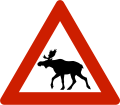
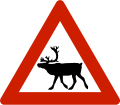
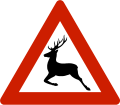
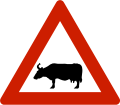
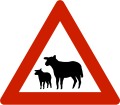
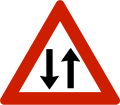
![Traffic queues likely[N 1]](/images/en/images/images/e/e1/120px-Norwegian-road-sign-149.0.svg.png)
![Low-flying aircraft[N 2]](/images/en/images/images/7/7d/120px-Norwegian-road-sign-150.0.svg.png)
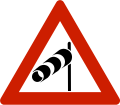
![Traffic accident[N 4]](/images/en/images/images/e/e4/120px-Norwegian-road-sign-153.png)
![Skiers[N 2] Warns that skiers often traverse or travel on the roads.](/images/en/images/images/a/a6/120px-Norwegian-road-sign-154.0.svg.png)
![Riders[N 2] Warns that riders often traverse or travel on the roads.](/images/en/images/images/8/87/120px-Norwegian-road-sign-155.0.svg.png)
